Cubism: The Leonard A. Lauder Collection at The Metropolitan Museum of Art will be the most important exhibition of the essential Cubists—Georges Braque (French, 1882–1963), Juan Gris (Spanish, 1887–1927), Fernand Léger (French, 1881–1955), and Pablo Picasso (Spanish, 1881–1973)—in more than 30 years.
The exhibition and accompanying publication will trace the invention and development of Cubism using iconic examples from the Leonard A. Lauder Collection, with its unparalleled holdings in this foundational modernist movement. The exhibition will mark the first time that the Collection, which Mr. Lauder pledged to the Museum in April 2013, is shown in its entirety.
The exhibition, which opens October 20, 2014, will present 79 paintings, works on paper, and sculpture: 17 by Braque, 15 by Gris, 15 by Léger, and 34 by Picasso. Rich in modernist pictures by Picasso and Braque, the exhibition will also include an unprecedented number of papiers collé by Juan Gris and a stunning array of Léger’s most famous series, his Contrasts of Forms.
Over the past 40 years, Leonard Lauder has selectively acquired masterpieces and seminal works to create the most important collection in private hands of works by the four preeminent Cubist artists: Mr. Lauder made his first two Cubist acquisitions in 1976 and continues to add to the Collection, which is distinguished by its quality, focus, and depth.
Over the past 40 years, Leonard Lauder has selectively acquired masterpieces and seminal works to create the most important collection in private hands of works by the four preeminent Cubist artists: Mr. Lauder made his first two Cubist acquisitions in 1976 and continues to add to the Collection, which is distinguished by its quality, focus, and depth.
Cubism was the most influential art movement of the 20th century: it radically destroyed traditional illusionism in painting, revolutionized the way we see the world (as Juan Gris said), and paved the way for the pure abstraction that dominated Western art for the next 50 years. Led by Picasso and Braque, the Cubists dismantled traditional perspective and modeling in the round in order to emphasize the two-dimensional picture plane. Cubist collage introduced fragments of mass-produced popular culture into pictures, thereby changing the very definition of art.
More than half of the Leonard A. Lauder Cubist Collection focuses on the six-year period, 1909-14, during which Braque and Picasso—the two founders of the Cubist movement—collaborated closely. Their partnership began in earnest in the fall of 1908, when the visionary dealer Daniel-Henry Kahnweiler exhibited Braque’s most recent paintings in his Paris gallery. Henri Matisse is known to have disparaged Braque’s pictures as “painting made of small cubes;” the term Cubism first appeared in print in Louis Vauxcelles’s review of the Kahnweiler exhibition.
The Collection includes two landscapes from this historic show:
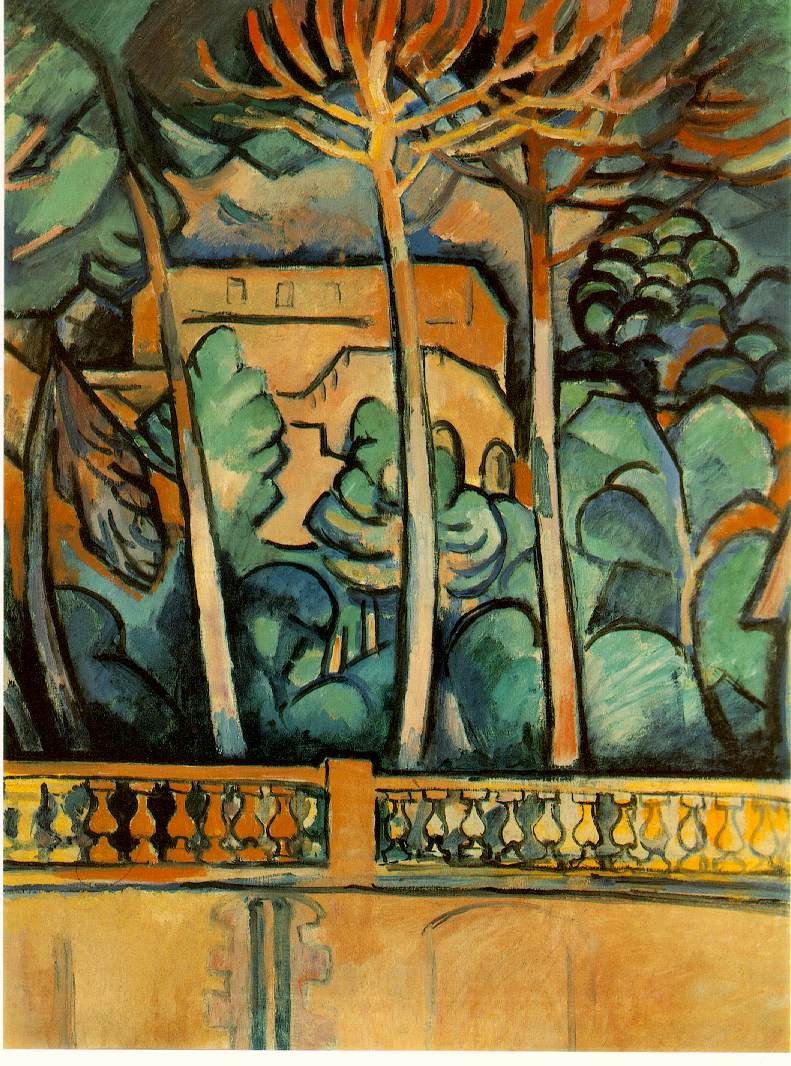
The Terrace at the Hôtel Mistral (1907),
which marks Braque’s transition from Fauvism to Cubism, and the iconic
Trees at L’Estaque (1908),
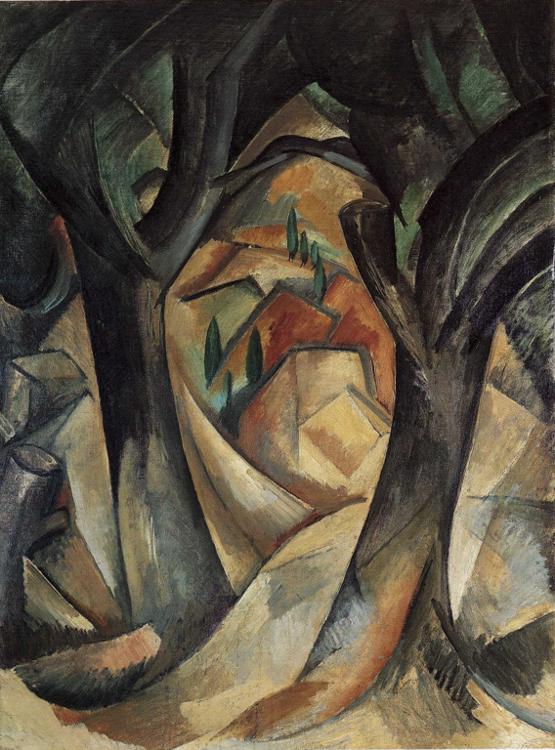
which inaugurates Cubism.
By 1909 Braque and Picasso were inseparable. As Picasso later recounted, “Almost every evening, either I went to Braque’s studio or he came to mine. Each of us HAD to see what the other had done during the day. We criticized each other’s work. A canvas wasn’t finished until both of us felt it was.”
A pair of identically sized paintings from 1911 in the Leonard A. Lauder Cubist Collection—
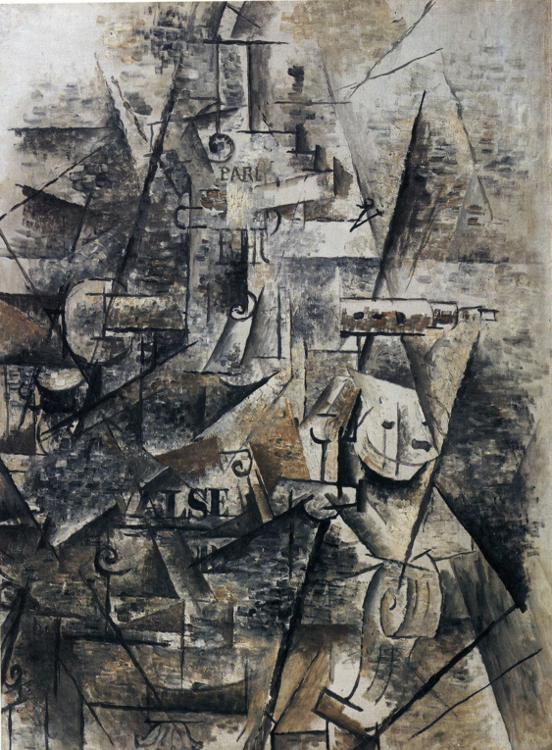
Braque’s Still Life with Clarinet (Bottle and Clarinet) and
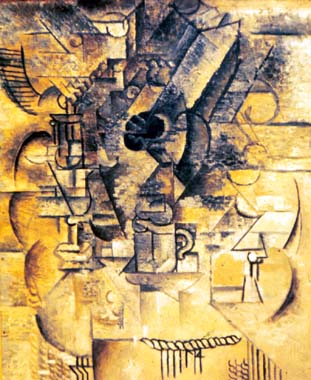
Picasso’s Pedestal Table, Glasses, Cups, Mandolin
— exemplify a pivotal moment in the history of Cubism, when the two artists began to picture objects from different points of view in an increasingly shallow space. Only a few clues were retained to help viewers decode the picture, the profile of an instrument or the tassel of a curtain. As the works hovered on the brink of illegibility, Braque and Picasso began to introduce “certainties,” as Braque called them: painted letters and words and, soon after, actual pieces of rope, newspaper, sheet music, and brand labels. They inspired other artists to incorporate all kinds of unorthodox materials into works of art.
The Leonard A. Lauder Cubist Collection contains such landmark paintings as Picasso’s landscape

The Oil Mill (1909),
which was one of the first Cubist pictures reproduced in Italy. After seeing it in the December 1911 issue of the Florentine journal La Voce, the Italian Futurists were inspired to modernize their style and engage in a rivalry with their French peers.

Picasso’s Still Life with Fan: “L’Indépendant” (1911),
in the Collection, is one of the first works in which he experimented with painted typography, in this case the gothic type masthead of L’Indépendant, the local newspaper of Céret in the foothills of the Pyrenees.

Braque’s Fruit Dish and Glass (1912),
the very first Cubist papier collé (paper collage) ever created, is also in the Collection. Collages were a revolutionary Cubist art form in which ready-made objects were incorporated into fine art. In the summer of 1912, while vacationing with Picasso in the south of France, Braque saw imitation wood-grain wallpaper in a store window. He waited until Picasso left town before buying the faux bois paper and pasting it into a still-life composition. Braque’s decision to use mechanically printed, illusionistic wallpaper to represent the texture and color of a wooden table marked a turning point in Cubism. Braque later recounted, “After having made the papier collé [Fruit Dish and Glass], I felt a great shock, and it was an even greater shock for Picasso when I showed it to him.”
Braque and Picasso shared an interest in aviation, which extended to Braque’s nickname, “Wilb[o]urg” (after Wilbur Wright). The most famous example of their aviation puns is

Picasso’s The Scallop Shell: “Notre Avenir est dans l’Air” (1912).
This oval-shaped painting is simultaneously a representation of a tabletop and a blatantly flat canvas. The still-life elements of the work include a trompe l’oeil rendering of a pamphlet that had been issued by the French government in February 1912 to raise public support for military aviation. Picasso included it as a witty reference to his and Braque’s daring, groundbreaking Cubist enterprise.
Picasso’s synthetic Cubist masterpiece

Woman in a Chemise in an Armchair (1913-14)
is one of the artist’s most radical and imposing paintings. This provocative and highly eroticized image was hailed by André Breton in his seminal text Surrealism and Painting (1928).
Additionally the Leonard A. Lauder Cubist Collection holds examples of two key Cubist sculptures: a rare cast of Picasso’s Head of a Woman (Fernande) (1909), which introduced the analytic Cubist style into three dimensions, and The Absinthe Glass (1914), which signaled the end of traditionally modeled sculpture. Each of the six casts in the edition was hand-painted by Picasso and includes an actual perforated tin absinthe spoon, thus blurring the boundaries between a multiple and a unique work of art.
Still lifes with flutes, guitars, mandolins, violins, and sheet music are indicative of Braque’s and Picasso’s personal pastimes as well as their enthusiasm for popular vaudeville tunes. Their word play and images combine ribald jokes and erudite references, high and low, as well as allusions to the Cubist movement and commentary on world events. In

Violin: “Mozart Kubelick” (1912),
for example, Braque indulged in a double entendre by including the name of the famed Czech violinist Jan Kubelik (1880-1940). The first three letters of his name (“KUB”) were those of a common bouillon cube, a foodstuff widely advertised on posters of the period, much to the delight of Braque and Picasso, who appreciated the pun on the word “Cub”ism. Violin: “Mozart/Kubelick” was one of three pictures by Braque that Kahnweiler sent to the New York Armory Show of 1913, the exhibition that introduced European modernism to the American public. It became one of the most caricatured Cubist images in the American press, which delighted in pointing out that Braque had put the “cube in Kubelik” and also that he had misspelled the maestro’s name.
Legend has it that, a few years earlier, on his way to visit Picasso at the Bateau-Lavoir, the rundown artist complex in Montmartre, Kahnweiler had glanced into the open window of Juan Gris’s studio and asked to see his work. In late 1912, the dealer began representing Gris. Whereas Braque and Picasso exhibited exclusively with Kahnweiler, Gris sent work to the annual Salon displays, bringing wider visibility to the new Cubist style. The Futurist artist Umberto Boccioni, for example, was directly influenced by
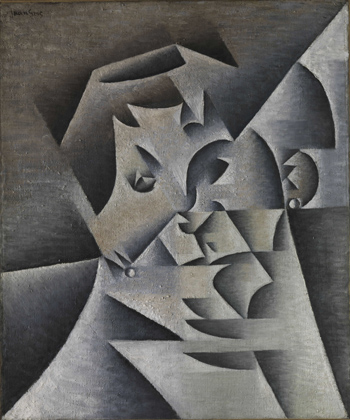
Gris’s Head of a Woman (Portrait of the Artist’s Mother)
after he saw it at the spring 1912 Salon des Indépendants. Gris took the analytic Cubism of Braque and Picasso and made it his own with precisely delineated compositions, flattened planes, and rhythmic surface patterns that prefigure the synthetic Cubism of the war years.
The Leonard A. Lauder Cubist Collection contains an unparalleled selection of six painted collages that Gris created during the first half of 1914. Several of them incorporate wry references to the fictional criminal mastermind Fantômas, the subject of a wildly popular crime series. The shadowy
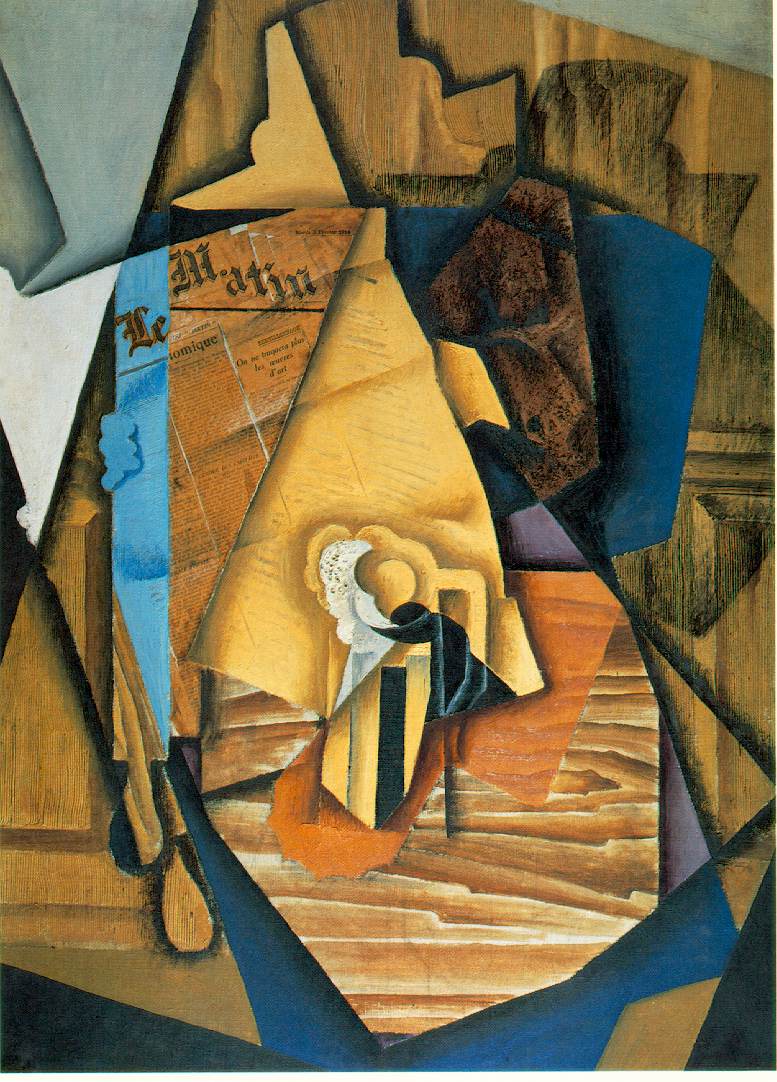
Man at the Café (1914)
hides his face behind a newspaper, made up of an actual clipping whose headline pointedly reads: “Bertillonage/ One will no longer be able to fake works of art.” Gris alludes to the criminal identification systems, or Bertillonage, of Alphonse Bertillon, one of the fathers of forensic science, whose methods were featured in the storylines of the Fantômas films. With mock suspense, Gris suggests that, having read about the latest criminal detection methods in the newspaper, the man at the table will escape the authorities once again—as will the Cubist masterminds in their games of visual deception.
In 1913, Kahnweiler added Fernand Léger to his stable of artists. Like Gris, Léger developed Cubism into a distinctive and influential style, in which dynamic intersections of spherical, cylindrical, and cubic forms evoked the new, syncopated rhythms of modern life. The Leonard A. Lauder Cubist Collection features several important works from Léger’s seriesContrasts of Forms, wherein Léger worked out his primary oppositions of light and dark, angled and curved planes, color and line. The jaunty image of

The Smoker (1914),
with its body reduced to basic geometric parts, anticipates the dehumanization that Léger would experience first-hand during World War I. Gris and Picasso, both Spanish citizens, remained in France during the war. Picasso’s political sentiments are evident in the Collection’s

Playing Cards, Glasses, Bottle of Rum: “Vive la France” (summer 1914; partially reworked 1915).
Braque and Léger were among the many French artists who were mobilized to the Front. Léger was injured and after more than a year’s hospitalization he began working on
Composition (The Typographer) (1918-19):


Fernand Léger, Composition (The Typographer) 1918-19. Oil on canvas. Promised Gift from the Leonard A. Lauder Cubist Collection © 2014 Artists Rights Society (ARS), New York / ADAGP, Paris
one of the largest Cubist works ever painted. Its mural-like size anticipates his collaboration in the 1920s with the architect Le Corbusier.Composition (The Typographer), the definitive version of a series of three, reflects the affinity Léger felt toward the anonymous working man and his fascination with the trappings of modern Paris, from advertisements to architecture. Léger drew on his background as an architectural draftsman in celebrating the beauty of machines and in this way led Cubism into a new modernist machine aesthetic.
A variety of education programs are planned in conjunction with this exhibition, including a teen program focusing on collage on October 18; a studio workshop, “Collage and Mixed Media: Cubist-Inspired Explorations” on November 16 and 23; a "Friday Focus" lecture by Emily Braun on December 5; a Sunday at the Met on January 25, 2015; film screenings on January 30; exhibition tours and gallery talks; and a Met Escapes art-making workshop for visitors with dementia.
Exhibition Credits
Cubism: The Leonard A. Lauder Collection is organized by Rebecca Rabinow, the Leonard A. Lauder Curator of Modern Art and Curator in Charge of the Leonard A. Lauder Research Center for Modern Art at the Metropolitan Museum, and Emily Braun, Curator of the Leonard A. Lauder Cubist Collection and Distinguished Professor of Art History at Hunter College and the Graduate Center of the City University of New York. Exhibition design is by Michael Langley, Exhibition Design Manager; graphics are by Connie Norkin, Graphic Design Manager; and lighting is by Clint Ross Coller and Richard Lichte, Lighting Design Managers, all of the Museum's Design Department.
Related Programs
A variety of education programs are planned in conjunction with this exhibition, including a teen program focusing on collage on October 18; a studio workshop, “Collage and Mixed Media: Cubist-Inspired Explorations” on November 16 and 23; a "Friday Focus" lecture by Emily Braun on December 5; a Sunday at the Met on January 25, 2015; film screenings on January 30; exhibition tours and gallery talks; and a Met Escapes art-making workshop for visitors with dementia.
Life & Times, a series of ticketed talks by curator Rebecca Rabinow, will take place on December 2 and December 9, 2014 shedding light on different aspects of the Leonard A. Lauder Collection. The first in the series, Cubist Confetti, considers the Cubists’ colorful stippling during the prewar years as a sophisticated means of introducing formal qualities of texture and light into their art, while referencing popular culture and artistic movements such as Pointillism. Games Cubists Play explores the impact of the games, jokes, and puns that define and characterize prewar Cubist masterpieces.
There will be a special lecture in The Grace Rainey Rogers Auditorium on February 11, Leonard Lauder, Collecting Cubism. Leonard A. Lauder will discuss the early influences that drew him to Cubism, the choices he made in acquiring works, and his criteria for assembling a world-class collection.
